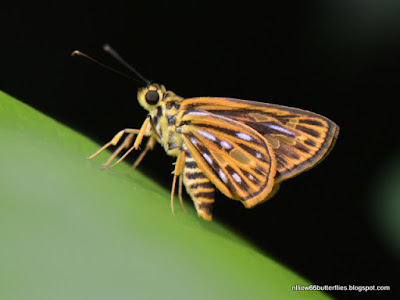Uncommon, found usually on flowering Leea indica and Chromolaena odorata bushes in shaded exposition in wooded countries.
Habitat indicator
Habitat indicator
RSP
|
WV
|
PG
|
VF
|
FTR
|
SC
|
LWDF
|
LWPF
|
LMEF
|
UMN
|
MN
|
x
|
x
|
x
|
Frequency observation
chart: (S marks the usual occurences, H marks an unusually high occurence, F
for first record)
2014
|
2015
|
||||||||||||
Nov
|
Dec
|
Jan
|
Feb
|
Mac
|
Apr
|
May
|
June
|
Jul
|
Aug
|
Sep
|
Oct
|
Nov
|
Dec
|
S4(F)
|
S4
|
S1
|
S4
|
S4(H)
|
S4
|
||||||||
Some keys to its ID:
-FW with silverstreak but no small hyaline spot in space 5
-HW vein 8 broadly orange on both sides
2016
|
|||||||||||
Jan
|
Feb
|
Mac
|
Apr
|
May
|
Jun
|
Jul
|
Aug
|
Sep
|
Oct
|
Nov
|
Dec
|
2017
|
|||||||||||
Jan
|
Feb
|
Mac
|
Apr
|
May
|
Jun
|
Jul
|
Aug
|
Sep
|
Oct
|
Nov
|
Dec
|
S12
|
|||||||||||
2018
|
|||||||||||
Jan
|
Feb
|
Mac
|
Apr
|
May
|
Jun
|
Jul
|
Aug
|
Sep
|
Oct
|
Nov
|
Dec
|
S12
|
|||||||||||
2019
|
|||||||||||
Jan
|
Feb
|
Mac
|
Apr
|
May
|
Jun
|
Jul
|
Aug
|
Sep
|
Oct
|
Nov
|
Dec
|
25 Dec 2014 @ 12:44
12:45
12:46
12:52
12:53
13:03
Above photos 31 Dec 2014
* * * * *
Above photos 15 Feb 2015 @ 11:30
S4: 24 Sep 2015 @ 11:36
* * * * *
in flight @ 10:21
10:22
10:24
10:25
10:26
10:26
10:27
Above photos 04 Oct 2015
a worn male from S4: 11 Oct 2015 @ 11:27
13:40

13:51
13:51
Above 3 different P. natuna from the same locality @ 17 Oct 2015
12:10
12:10
* * * * *
Above photos 15 Feb 2015 @ 11:30
S4: 24 Sep 2015 @ 11:36
* * * * *
A number can be seen visiting flowering bushes at certain times of the year where it occurs...
in flight @ 10:21
10:22
10:24
10:25
10:26
10:26
10:27
Above photos 04 Oct 2015
a worn male from S4: 11 Oct 2015 @ 11:27
13:40

13:51
13:51
Above 3 different P. natuna from the same locality @ 17 Oct 2015
Above 2 photos 08 Nov 2015 @ 10:32
12:10
12:11
Above photos 06 Jan 2018


























I was in Brunei in 1985 and photographed this butterfly laying an egg on bird poo. Perhaps part of the life cycle is guano.
ReplyDeleteNot true and true in a way. Many butterflies especially the males (and other insects too) visit animal droppings to get minerals for their reproductive needs. That is why they are often seen congregating on sunny seepages.
ReplyDelete